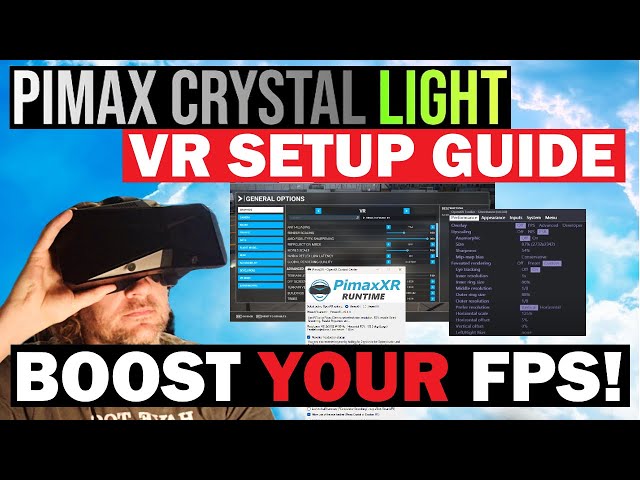Welcome to our detailed guide on configuring the Pimax Crystal Light VR headset for Microsoft Flight Simulator (MSFS). Whether you're running a 3070 Ti, 4070 Ti, or 4090 GPU, this guide will help you optimize your settings for the best VR experience.
This blog is based on a video by VR Flight Sim Guy, a seasoned YouTuber with many years of experience in sim flight. His original video will be attached below. If you want to learn more about sim flight, be sure to subscribe to his channel and follow his videos.
Essential Tools and Software
Before diving into the settings, ensure you have the necessary tools:
-
PX XR Switcher: This tool is crucial for optimizing VR settings. Thanks to its developer, Matt, the VR community has seen significant improvements. Download and run it once if you’re using the Pimax Crystal Light specifically for MSFS.
-
Pimax XR Runtime: Preferred over Steam VR for this headset, it ensures better performance.
-
OpenXR Toolkit: Optional but recommended for advanced settings and tweaks.
General VR Settings
Recommended Settings for Different GPUs
-
RTX 3070 Ti:
-
DirectX: Use DirectX 12.
-
DLSS: Enabled (DLSS is beneficial for lower-end GPUs like the 3070 Ti).
-
Resolution Override: Use the OpenXR Toolkit to set a resolution around 3500 by 4142.
-
Render Quality: Set to around 75 in the Pimax Play software.
-
-
RTX 4070 Ti:
-
DirectX: Use DirectX 12.
-
DLSS: Optional (can be enabled for better performance).
-
Resolution Override: Similar to 3070 Ti, around 3500 by 4142.
-
Render Quality: Set to maximum if performance allows; otherwise, adjust to balance clarity and performance.
-
-
RTX 4090:
-
DirectX: Use DirectX 12.
-
DLSS: Generally not needed due to the GPU's power.
-
Resolution Override: Maximize settings using OpenXR Toolkit or Pimax Play.
-
Render Quality: Set to maximum.
-
Detailed Settings Breakdown
-
Terrain Level of Detail:
-
3070 Ti: Set to 50-75.
-
4070 Ti: Set to 75-100.
-
4090: Can be set higher, but keep below 150 for optimal performance.
-
-
Offscreen Terrain Pre-Caching:
-
Set to High for all GPUs. Ultra is not significantly better but impacts performance.
-
-
Buildings, Trees, Grass and Bushes:
-
Set to High for better visuals without a heavy performance hit.
-
-
Volumetric Clouds:
-
Set to High instead of Ultra. Ultra settings greatly impact FPS without significant visual improvements.
-
-
Texture Resolution:
-
3070 Ti & 4070 Ti: Medium to High.
-
4090: Ultra.
-
-
Anisotropic Filtering (AF):
-
Set to 16x for all GPUs.
-
-
Shadows and Ambient Occlusion:
-
Set Shadows to Low or Medium.
-
Set Ambient Occlusion to Medium, even for the 4090.
-
-
Bloom and Glass Cockpit Refresh Rate:
-
Bloom is optional; enable if you prefer the visual effect.
-
Set Glass Cockpit Refresh Rate to High for smoother gauge readings.
-
Advanced Settings and Optimizations
-
Refresh Rate:
-
90 Hz is recommended for a balance between smoothness and performance.
-
Lower refresh rates (75 Hz or 60 Hz) can be used if you prefer and if your system can handle the lower FPS.
-
-
Fixed Foveated Rendering (FFR):
-
Enable in OpenXR Toolkit for better performance.
-
Use preset or custom settings to balance quality and performance.
-
-
Frame Rate Lock:
-
Set to half of your refresh rate (e.g., 45 FPS for 90 Hz) for smoother experience.
-
-
Hardware Accelerated GPU Scheduling (HAGS) and Game Mode:
-
Enable both for better performance.
-
-
Traffic Settings:
-
Use real-time online traffic instead of AI offline traffic to reduce CPU load.
-
Final Tips
-
Regularly update your GPU drivers and VR software.
-
Use Smooth Flight or Auto FPS programs for dynamic LOD adjustments.
-
Experiment with settings in different locations within MSFS to find the optimal balance between performance and visual quality.
If you have any questions about setup, feel free to join our Discord Channel. We hold Q&A sessions frequently, and you can post your questions in the corresponding channels. For technical help, please submit a ticket here: Support Ticket.








